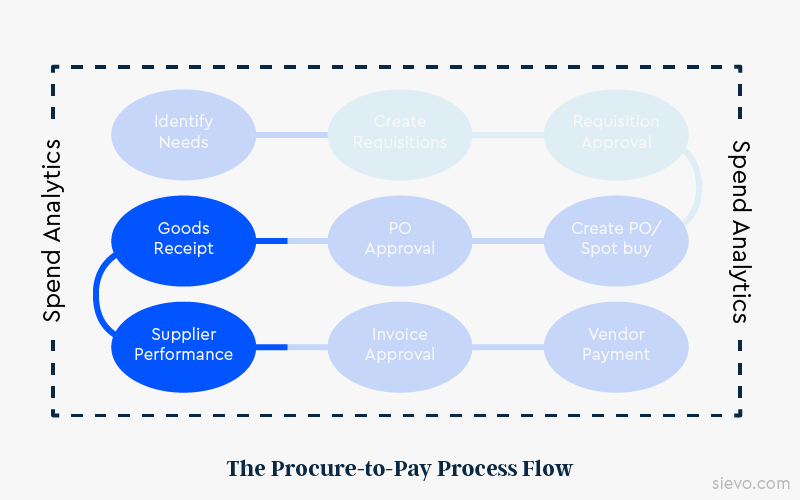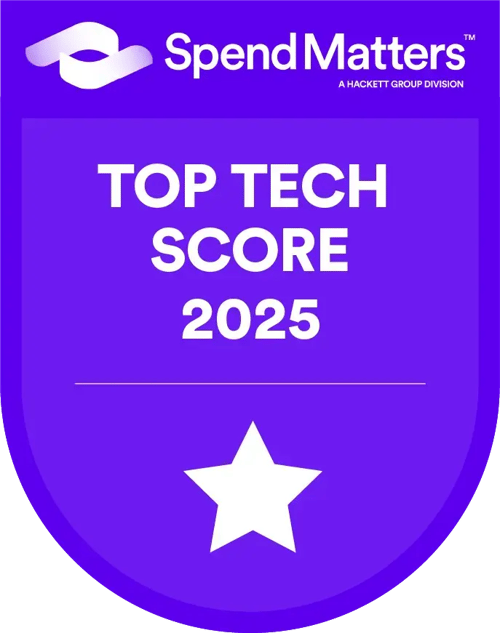Handling large volumes of procurement data efficiently is time-consuming and labor-intensive, especially when data is sourced from various systems.
So, the P2P process creates a lot of procurement data, and also requires a lot of data to get right.
What makes the process even more challenging is the many levels of authorization required within procurement and accounts payable to satisfy financial controls.
Automating the P2P cycle provides better insight into processes, fewer errors, and easier fraud detection.
Procurement data is produced during every step of the P2P process. Integrated P2P analytics can change the game in 5 key ways:
- Consolidation of your P2P data.
- Visibility into purchasing transactions in digestible dashboards.
- Bottleneck identification and process improvements.
- Risk identification and mitigation.
- The opportunity to optimize cash flow and budget expenditure more accurately.
This article will show the benefits of automated spend analytics in your P2P process and how you can get more insights from visibility into the P2P cycle.
What is the Procure-to-Pay (P2P) process?
The procure-to-pay process involves the whole purchasing cycle, from identifying needs, selecting vendors, keeping compliance, receiving, and paying.
Here's an overview of the steps.
Note that some organizations have not implemented purchase requisition creation and approval as part of their P2P process. For some products or entire categories the process may look different within the same organization.

The process can become complicated as it cuts across multiple functions and involves many sub-processes and human interventions.
Procurement data is the byproduct of the P2P process. Data is generated every step of the way, like in the PO process and payment.
That's why Spend Analytics can make sure your data is giving you the insights you need to make strategic decisions.
Learn the 4 simple steps to increase spend under management
The benefits of analytics in P2P
What purpose does spend analytics serve in P2P? The biggest benefits are that the P2P process data can be used to optimize processes and mitigate risks.
Factors such as payment terms, PO coverage, and contract terms should all be subject to careful analysis to ensure you're performing optimally. An automated analytics solution provides a way of generating and presenting information in a user-friendly way at the level of category, process, contract, and item.
P2P analytics can deliver powerful insights that highlight inefficiencies and speed up decision-making. Analytics reveals bottlenecks and process pain points. Consider the benefits of measuring the average time to approve a purchase order. The results can be measured against industry benchmarks.
Mitigating risk in P2P can span everything from reducing maverick spend to gaining full value from contracts. Fraud and non-compliance is easily detected when relevant controls and approvals are in place.
Examples of spend analytics in the P2P cycle
Spend analytics has a role to play in every step of the P2P cycle.
Analytics in need identification

Let's start with the most obvious use case: need identification. Spend analysis is the best way to identify...
- Where you're buying (Suppliers)
- What you're buying (Categories)
- Who's buying (Cost Centers)
With that information, you can make smart decisions about supporting your procurement and category goals.
Read all about Spend Cubes: what are they made up of?
Analytics in PO Approval

The time taken to approve a Purchase Requisition (PR) to the approval of the Purchase Order (PO) is a constant headache for the end user. When you have a business-critical project that is moving forward, you don't want to waste weeks waiting for the PO approval.
POs can be analyzed in many ways (e.g., volume per buyer, the average value of POs, ordering frequency, POs by department), which show you how you can streamline PO activities.
Analytics can find the bottlenecks and help you devise ways to speed them up. Accepted benchmarks can be used to compare and uncover reasons for the delay.
Analytics in supplier performance

Supplier performance metrics are often documented or at least agreed upon verbally between buyer and supplier.
With analytics integrated inwithhe P2P process, you gain greater leverage and visibility over common Procurement KPIs like:
- % of deliveries received in full
- % of deliveries more than 10% late
- % of rejects or returns
- % services delivered/not delivered by the due date
More sophisticated measures include the frequency and timing of late deliveries.
Data can answer questions like “what was the number of days taken from order to receipt compared to the agreed order-to-delivery time?" and "How does this compare to other similar suppliers?”
Analytics in vendor payment

Payment analytics can provide multiple views into payments to suppliers, including early and late payments. Whether 30 days late or 7 days early, all invoices impact cash flow and budgeting.
Early payment plans usually incorporate a benefit to the buyer. The data can tell you where discounts have been lost.
Payment term spend analysis lets you explore opportunities for payment term optimization and savings and opens doors to renegotiation of contract terms.
Reducing risk in the P2P cycle
Spend analytics can enhance every step of the P2P process. From a holistic point of view, we've addressed how analytics can optimize your processes. But how does analytics reduce risk?
Classifying spending by department, location, or end user can identify unauthorized purchases (maverick buying) and purchases outside the contract.
Every invoice coming from an unknown vendor should be analyzed. Has a supplier changed their name? Is it a maverick buy? Is it attempted fraud?

Areas of risk that can be aided by spend analytics include:
- Orders with no contract
- Orders with no PR
- High-value orders with no approved PO
- One-time suppliers
- Invoice with no matching PO
- Split PO to avoid higher-level approval
- Employees registered as suppliers
- Suppliers that are friends or family of employees
- Duplicate suppliers
- Variations from contracted pricing
- Payment without formal goods received documentation
The reasons for unauthorized purchases may be negligence, poor compliance, loose controls, or intentional fraud. No matter the reason, you're much more likely to spot errors with robust analytics in P2P.
How to benefit from P2P Analytics
Sievo’s P2P spend analysis solutions have assisted our clients in improving their transactional spend management. Learn how you can improve your P2P process by booking a demo today.







